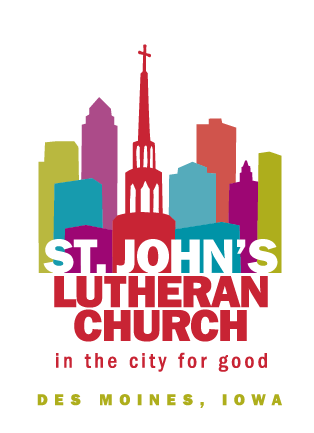History of St. John's
First church, 1869 - 1890, located at 7th & Grand. Name was changed to St. John's in 1881.
It was May 1865. Th e Civil War had just ended. In the still small town of Des Moines, Iowa, Rev. Morris Offi cer, one of America’s most prominent 19th Century Lutheran missionaries, was holding house meetings. He had been traveling the western frontier of the Midwest seeking to establish English-worshiping Lutheran congregations for the General Synod, an Eastern U.S. body formed earlier in the 19th Century. Upon arriving in Des Moines, he was said to be “pleased with the town, but made to mourn over the wasted condition of the Lutheran Church.” Still, he managed to identify a small group interested in forming a congregation. He appointed a committee of four people—two men and two women—to search for interested people in the area while he continued his travels, and then subsequently found a pastor willing to take on this mission project, Rev. Andrew M. Geiger.
Second building, 1890 - 1935, red brick building located at Sixth & Chestnut (now Keo).
Among Rev. Henry’s fi rst steps to increase the scope of St. John’s ministry was organizing a chapter of the Women’s Home and Foreign Missionary Society. Th e group’s secretary later fi led this report, “Th is year we have studied the ‘Islands of the Sea’ at six of our meetings, which has given us much information in regard to the infl uence of the gospel among these island people... Our Home Department is very encouraging both in interest, in literature and voluntary giving... We have assisted South Omaha and Clarksburg, Va. and the Iowa Home Missionary.” In just his second year, Rev. Henry and the congregation proudly served as hosts of the Th irtieth Convention of the Iowa Synod (but only after giving their church building a new coat of paint both inside and out). By 1889, the now-150-member congregation felt ready to entertain the overtures it had been receiving for its increasingly valuable property at Seventh and Sycamore (Des Moines by then had grown to a population of 50,000) and proceed with planning for a new church building. A $15,000 offer for the property was accepted in July 1889—consisting of $7,000 cash and an $8,000 piece of property at Sixth and Chestnut (later Keosauqua Way and now Watson Powell Jr. Way), the corner where St. John’s still worships. Within just two months, builders laid a cornerstone at that site for a new church, and on March 23, 1890, services were held for the first time in the building’s basement. Because the congregation was determined not to take on indebtedness and committed to proceeding only as money allowed, it wasn’t until February 28, 1892, that dedication services were held in the grand building that came to be called the “Red Brick Church,”which served the congregation for the next 43 years.




